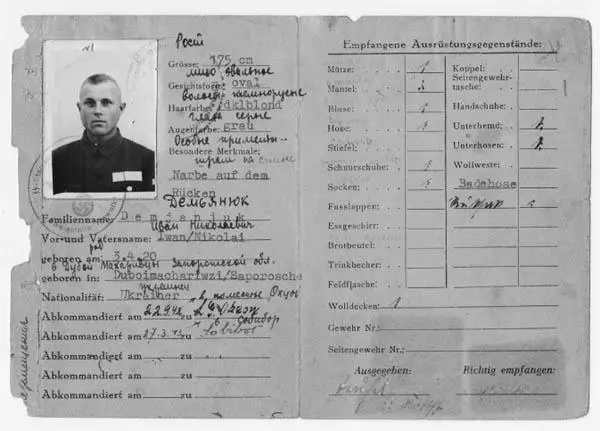

• • •
The village of Trawniki is a few miles northwest of the village of Sobibor, where, on his visa application, Demjanjuk had sworn he worked as a farmer before and during the early part of the war. Trawniki’s landmark was an abandoned sugar refinery near the railroad tracks. The SS established a school for auxiliary guards on the site. In 1942, the year Demjanjuk was captured by the German army during the battle of Kerch, nearly all of the auxiliary guards in training at Trawniki were Red Army prisoners recruited from POW camps in eastern Poland and western Ukraine, especially from Rovno and Chelm, where Demjanjuk said he had been held prisoner.
Just as the SS could not round up, rob, and kill the 2.1 million Jews in Russia and the Soviet-occupied territories east of the Bug River without the help of volunteers ( Hiwis ), it also couldn’t round up, transport, rob, and kill the 3.3 million Polish Jews in Operation Reinhard without help. Nor could the SS guard the thousands of labor and concentration camps it had built throughout Poland and Western Europe without help that included civilian employees like Hermine Braunsteiner, the Mare of Majdanek. In the fall of 1941, while German and Hiwi Einsatzkommandos were shooting Jews by the thousands in the forests of the Soviet-occupied territories and loading their stolen valuables onto lorries destined for the Reich, the SS opened the Trawniki school.
The SS envisioned a disciplined corps of one hundred thousand guards but ultimately fell far short of that goal. By July 1944, when the Red Army captured the town of Trawniki, the school had only trained approximately five thousand, and they were far from disciplined.
The SS deliberately chose Soviet POWs to become “Trawniki men,” as they were called, because they already had military training, had seen action, and were no strangers to death and killing. Most were Ukrainians, the largest ethnic group among the prisoners. The SS favorites were ethnic Germans ( Volksdeutsche ) from eastern Poland, Belorussia, and Ukraine. They were loyal to Germany—therefore they could be trusted—and they spoke both German and Ukrainian.
Major General Odilo Globocnik, the SS officer and police leader who ran Operation Reinhard and its death camps in the Lublin district of Poland, appointed SS Captain Karl Streibel as Trawniki’s first and only commandant. Initially, Streibel personally visited the POW camps to select candidates for his new school.
Before Streibel or his recruiters visited a POW site, camp security personnel conducted a preliminary screening of potential candidates. That narrowed the number of prisoners Streibel and the doctor he brought with him had to interview and evaluate.
The first selection criterion was good health. If a Soviet POW was in reasonably good physical shape under starvation conditions, he would be cheaper to maintain, and easier to train and deploy. Furthermore, good health more than likely signaled that the prisoner had received extra rations for providing a service to the camp staff. That meant he had already crossed a line by collaborating with the enemy to stay alive.
Besides healthy men, Streibel wanted anticommunists who would be less likely to desert to the Red Army, and anti-Semites who would find it easier to brutalize and kill Jews. The ability to understand and speak German and the skill to drive a transport truck made a candidate especially valuable to the SS and its mission in Poland to capture, rob, and kill all Polish Jews with speed and efficiency.
The vast majority of the POW Trawniki men, most in their early twenties or younger, did not volunteer. They were recruited to collaborate without being specifically told for what. As an inducement to work with the Germans, they were promised better food and warm clothes. If the SS had asked for volunteers, however, they would have been deluged. Life in a POW camp in 1941–42 (especially 1941) was a virtual death sentence. The Germans shot hundreds of thousands of Soviet prisoners they didn’t know what to do with. Starvation and disease were rampant. Soviet POWs would volunteer for almost anything for an extra crust of bread.
“Because we were all starving,” a former Trawniki man recalled after the war, “no one… who had been selected, refused.”
Of course, if a POW was selected to collaborate, he could always refuse. If he did, depending on who was the recruiter that day, he could be killed or sent back into the prison ranks, where he had less than a 20 percent chance of surviving. There is at least one recorded instance of a group of Soviet POWs refusing the offer to collaborate and not being shot.
Most trainees from the POW camps arrived at Trawniki relatively healthy, but undernourished and in rags. They were cleaned up, deloused, given a haircut, and clothed in recycled military uniforms—black ones made from old SS uniforms or Polish army uniforms dyed black, or earth-brown Belgian military uniforms appropriated from the warehouses of Reich-occupied Belgium.
Most of the time, an SS officer would explain to the new recruit—through a Volksdeutsche interpreter—that he would be trained at Trawniki for guard duty and that he would not be asked to fight against Soviet soldiers. When his training as an SS guard was completed, the officer would explain, he could be assigned guard duty at a factory, airport, labor camp, or concentration camp. He might also be ordered to help the police round up and transport Jews to camps.
After the lecture, the new recruit would be given the choice to accept the assignment or return to a POW camp. “No one wanted to return,” a former Trawniki man from Chelm (Stalag 319) explained after the war. The POWs feared they would either be shot if they said no or would starve to death in a camp. Although camp conditions had improved after the terrible winter of 1941–42 because the Germans decided to use Soviet POWs as forced laborers, the fear of starvation was still very real.
An ethnic German interviewed the recruits and recorded their data on a personnel form ( Personalbogen ) that included their name, birth date and place of birth, language and occupational skills, military service, and marital status. The interviewer looked the new recruit over, then recorded the color of his hair and eyes and his height. A print was made of his right thumb. A photographer took his picture. Then, based on the information on his personnel record, he received an identification number and an ID card (service pass).
The identification number was important in the German human accounting system. It was the number, not the name, that administrators used on most routine documents such as personnel rosters. The service pass was equally important. How else would a Trawniki man explain to a local police officer why he was wearing an unusual uniform, carrying a gun, unable to speak German, and walking in a restricted area?
The new recruit had to sign a service obligation form swearing allegiance to the SS and promising to abide by the rules, regulations, and disciplines of the guard service ( Wachmannschaften ) under the supervision of the SS and German police. He also had to swear that he did not have Jewish blood and that he had not been a member of the Communist Party or the Komsomol communist youth organization.
The Trawniki students received specialized training of no predetermined length of time. It could last several months or several weeks depending on the SS need for auxiliary guards. The training included: general guard procedures; German language lessons focusing on understanding basic commands in German; firearms instruction in the use and care of German-issued rifles, pistols, machine guns, submachine guns, and grenades; crowd control and roundup techniques; and German ideology. Like all military units, the recruits marched and sang (German songs).
Читать дальше














